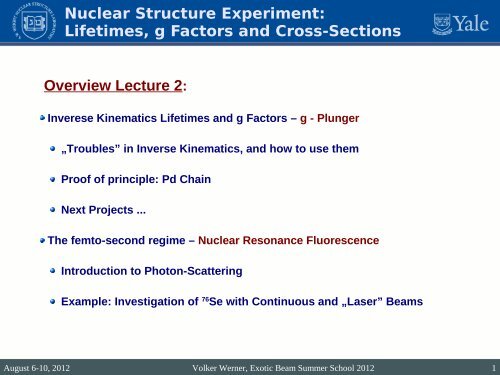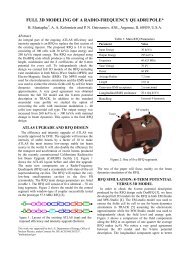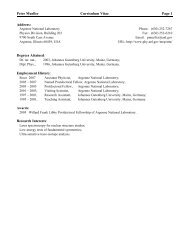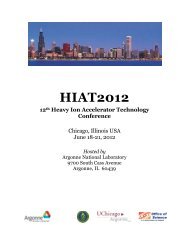Nuclear Structure Experiment - II
Nuclear Structure Experiment - II
Nuclear Structure Experiment - II
You also want an ePaper? Increase the reach of your titles
YUMPU automatically turns print PDFs into web optimized ePapers that Google loves.
<strong>Nuclear</strong> <strong>Structure</strong> <strong>Experiment</strong>:<br />
Lifetimes, g Factors and Cross-Sections<br />
Overview Lecture 2:<br />
Inverese Kinematics Lifetimes and g Factors – g - Plunger<br />
„Troubles” in Inverse Kinematics, and how to use them<br />
Proof of principle: Pd Chain<br />
Next Projects ...<br />
The femto-second regime – <strong>Nuclear</strong> Resonance Fluorescence<br />
Introduction to Photon-Scattering<br />
Example: Investigation of 76 Se with Continuous and „Laser” Beams<br />
August 6-10, 2012 Volker Werner, Exotic Beam Summer School 2012 1
v/c ~<br />
5-10%<br />
(g-)Plunger <strong>Experiment</strong>s<br />
Recoil Distance Doppler Shift (RDDS) method<br />
-> pico-second regime<br />
NYPD<br />
August 6-10, 2012 Volker Werner, Exotic Beam Summer School 2012 2
Plunger: Recoil Distance Method<br />
Light<br />
Beam,<br />
e.g. O<br />
Yale Plunger<br />
Heavy<br />
Target X<br />
v/c ~ 2 %<br />
Y *<br />
Doppler shifted<br />
in-flight<br />
Plunger<br />
foils<br />
Stopper<br />
e.g. Au<br />
or non-shifted after<br />
stopping<br />
August 6-10, 2012 Volker Werner, Exotic Beam Summer School 2012 3
Inverse Kinematics<br />
Recoil Distance Method<br />
v/c~5-10%<br />
X X *<br />
Dopplershifted<br />
High recoil velocity<br />
-> large separation of peaks<br />
(and some problems we<br />
didn't have before....)<br />
All I show is Coulomb Excitation<br />
-> direct excitation, no feeding !<br />
not Dopplershifted<br />
August 6-10, 2012 Volker Werner, Exotic Beam Summer School 2012 4<br />
γ D<br />
Important now,<br />
next order<br />
� �<br />
21 � 01<br />
+ β 2 /2
Inverse Troubles<br />
Intensity correction of γ�rays<br />
Attenuation coefficients (solid angle) of the detectors - Q<br />
Solid angle of the particle detector – attenuation of the angular distribution<br />
Lorentz boost<br />
<strong>Nuclear</strong> Deorientation<br />
Hyperfine Interaction:<br />
Precession of the nuclear spin I<br />
and the electron spin J about the<br />
total spin F<br />
dΩ/dΩ' = (Eγ/Eγ 0 ) 2 = [1 + (Eγ-Eγ 0 )/Eγ 0 ] 2<br />
F = I + J<br />
J electron spin<br />
randomly oriented<br />
I nuclear spin<br />
aligned by reaction<br />
A. E. Stuchbery et al., Phys. Rev. C 76 (2007) 034307<br />
August 6-10, 2012 Volker Werner, Exotic Beam Summer School 2012 5
<strong>Nuclear</strong> Deorientation (RIV)<br />
Make use of “Recoil Into Vacuum” (RIV)<br />
=> Angular distribution is attenuated!<br />
By precession of the nuclear spin due to<br />
the hyperfine interaction<br />
� deorientation coefficients.<br />
F = I + J<br />
W(θ)=1 + Σ i=2,4 G i (t) Q i B i F i P i (cos θ)<br />
J electron spin<br />
randomly oriented<br />
I nuclear spin<br />
aligned by reaction<br />
G i depend on magnetic moment (interacting with electrons)<br />
G k (t)=α k +(1-α k )∙exp[-(g∙d)/(v∙C k )]<br />
A. Stuchbery et al., PRC 76, 034307 (2007)<br />
Distance dependent angular distribution:<br />
� 3 parameters: α k , g, C k<br />
August 6-10, 2012 Volker Werner, Exotic Beam Summer School 2012 6
Angular Distributions<br />
Initial alignment characterized by:<br />
„statistical tensor”<br />
and is the m component of the nuclear WF,<br />
and m is the component of the spin along<br />
stat. coefficients and attenuation<br />
due to solid angle... can be calculated<br />
analytically<br />
the z-axis<br />
Since we use Coulomb excitation, which is a well-known E-M process,<br />
all the above can be calculated from Coulex Theory.<br />
August 6-10, 2012 Volker Werner, Exotic Beam Summer School 2012 7
Parameters going into HF<br />
Charge state of the ion exiting the target.<br />
H. Betz, Rev. Mod. Phys. 44, 465 (1972)<br />
Depends on velocity. Average charge state is reached while passing through<br />
the target foil.<br />
(Avg. charge state reached within a fraction of the target at these velocities.)<br />
-> Avg. charge state determines atomic physics (electron-configurations)<br />
August 6-10, 2012 Volker Werner, Exotic Beam Summer School 2012 8
Parameters going into HF<br />
Typical values: HF – splittings 10 -6 – 10 -7 eV ; B HF ~ 2-3 kT<br />
We don't quite know the atomic physics (values of I ).<br />
August 6-10, 2012 Volker Werner, Exotic Beam Summer School 2012 9
Deorientation<br />
Since the nuclear ensemble is deorienting with time, we need a factor (function)<br />
to take this into account:<br />
If there is no stopper (that is „normal” Recoil Into Vacuum – RIV):<br />
If we would know the electron configurations (but we don't)<br />
with excited state lifetime τ<br />
(for each electron<br />
configuration)<br />
August 6-10, 2012 Volker Werner, Exotic Beam Summer School 2012 10
Too Complicated !<br />
We need a more empirical approach:<br />
q(J) is a distribution of electron configurations.<br />
Let us assume that electronic configurations (states) are much longer-lived<br />
than the excited nuclear state -> Static Limit !<br />
If the electronic states have a broad distribution, then the Larmor frequencies<br />
of the precessions are also broadly distributed.<br />
-> Broad distribution of Larmor frequencies with some Lorentzian distribution<br />
width Γ k , which depends on the nuclear magnetic moment.<br />
Broad distribution leads to exponential behavior of G k , and the initial orientation<br />
will never completely be destroyed -> „hard-core” parameter α k<br />
we use as a parameter, since F, J unknown<br />
August 6-10, 2012 Volker Werner, Exotic Beam Summer School 2012 11
<strong>Nuclear</strong> Deorientation (RIV)<br />
Make use of “Recoil Into Vacuum” (RIV)<br />
=> Angular distribution is attenuated!<br />
By precession of the nuclear spin due to<br />
the hyperfine interaction<br />
� deorientation coefficients.<br />
F = I + J<br />
W(θ)=1 + Σ i=2,4 G i (t) Q i B i F i P i (cos θ)<br />
J electron spin<br />
randomly oriented<br />
I nuclear spin<br />
aligned by reaction<br />
G i depend on magnetic moment (interacting with electrons)<br />
G k (t)=α k +(1-α k )∙exp[-(g∙d)/(v∙C k )]<br />
A. Stuchbery et al., PRC 76, 034307 (2007)<br />
Distance dependent angular distribution:<br />
� 3 parameters: α k , g, C k<br />
August 6-10, 2012 Volker Werner, Exotic Beam Summer School 2012 12
10x Pd<br />
G - Plunger<br />
24 Mg 0.6 mg/cm 2<br />
target<br />
x<br />
nat Cu 15 mg/cm 2<br />
stopper<br />
Particle<br />
detector<br />
High recoil velocity (v/c ~ 6 %)<br />
-> large Doppler shift allows precise lifetime measurement<br />
August 6-10, 2012 Volker Werner, Exotic Beam Summer School 2012 13
T-Dependent Angular Distribution<br />
(or: TDRIV)<br />
W(θ)=1 + Σ i=2,4 G i (t) Q i B i F i P i (cos θ)<br />
80 �m<br />
Doppler-shift<br />
Stopped<br />
5 �m 20 �m 50 �m<br />
150 �m 250 �m<br />
Example of experimental and theoretical calculation of angular<br />
distribution for the stopped and the Doppler shift component<br />
August 6-10, 2012 Volker Werner, Exotic Beam Summer School 2012 14
G - Plunger TDRIV analysis<br />
G k (t)=α k +(1-α k )∙exp[-(g∙(d-d 0 )/(v∙C k )]<br />
A. Stuchbery et al., PRC 76, 034307 (2007)<br />
“calibrate” C k of in one isotope with known g factor ( 106 Pd)<br />
- measure the time dependent attenuation<br />
- “calibrate” an isotopic chain<br />
C 2 =32.3(6.4)�m<br />
� 2 =0.23(5)<br />
+ 106 NNDC<br />
g(2 ; Pd) = +0.398(21)<br />
1<br />
C 4 =16.0(2.2)�m<br />
� � =0.07(3)<br />
August 6-10, 2012 Volker Werner, Exotic Beam Summer School 2012 15
We have 2 Peaks – use them !<br />
stopped peak:<br />
flight peak (decayed somewhere on the way):<br />
August 6-10, 2012 Volker Werner, Exotic Beam Summer School 2012 16
Simultaneous fit for each Isotope<br />
August 6-10, 2012 Volker Werner, Exotic Beam Summer School 2012 17
G - Plunger Lifetime Analysis<br />
(doppler-shift) (total)<br />
Negligible feeding => simple decay curve: P(d) = I / Iγ<br />
γ<br />
�=19.87(14) ps<br />
106 Pd<br />
P(d) = 1 – exp[ - λ∙(d-d 0 )] ; λ = 1/ (v∙τ)<br />
without deorientation correction<br />
with deorientation correction<br />
17.60�0.57<br />
19.87�0.14<br />
August 6-10, 2012 Volker Werner, Exotic Beam Summer School 2012 18
Relative g-Factor Measurements<br />
(The method does not give the sign of the g factor !)<br />
Reference<br />
Adopted value 1 +0.46(4) +0.398(21) +0.36(3)<br />
+ 104 106 108<br />
g(2 ) Pd Pd Pd<br />
1<br />
This work |0.52(10)| 0.40(2) |0.32(5)|<br />
IBM-2 2 0.42 0.392 0.366<br />
Shell-Model 0.5<br />
1 Evaluated <strong>Nuclear</strong> <strong>Structure</strong> Data File<br />
2 Kim, Gelberg, Mizusaki, Otsuka, von Brentano, Nucl. Phys. A 604, 163 (1996)<br />
3 G. Gurdal et al., Phys. Rev. C 82, 064301 (2010); SM-Int: JJ45PN (Hjorth-Jensen), Ni-core, fpg, dg<br />
August 6-10, 2012 Volker Werner, Exotic Beam Summer School 2012 19
Relative g-Factor Measurements<br />
(The method does not give the sign of the g factor !)<br />
Reference<br />
Adopted value 1 +0.46(4) +0.398(21) +0.36(3)<br />
+ 104 106 108<br />
g(2 ) Pd Pd Pd<br />
1<br />
This work |0.52(10)| 0.40(2) |0.32(5)|<br />
Ref3 0.48(1)(?)<br />
This w. Rescaled |0.62(10)| 0.48(1) |0.38(5)|<br />
IBM-2 2 0.42 0.392 0.366<br />
Shell-Model 0.5<br />
1 Evaluated <strong>Nuclear</strong> <strong>Structure</strong> Data File<br />
2 Kim, Gelberg, Mizusaki, Otsuka, von Brentano, Nucl. Phys. A 604, 163 (1996)<br />
3 G. Gurdal et al., Phys. Rev. C 82, 064301 (2010); SM-Int: JJ45PN (Hjorth-Jensen), Ni-core, fpg, dg<br />
August 6-10, 2012 Volker Werner, Exotic Beam Summer School 2012 20
Relative g-Factor Measurements<br />
(The method does not give the sign of the g factor !)<br />
Reference<br />
Adopted value 1 +0.46(4) +0.398(21) +0.36(3)<br />
+ 104 106 108<br />
g(2 ) Pd Pd Pd<br />
1<br />
This work |0.52(10)| 0.40(2) |0.32(5)|<br />
Ref2 0.48(1)(?)<br />
This w. Rescaled |0.62(10)| 0.48(1) |0.38(5)|<br />
IBM-2 2 0.42 0.392 0.366<br />
Shell-Model 0.5<br />
1 Evaluated <strong>Nuclear</strong> <strong>Structure</strong> Data File<br />
2 Kim, Gelberg, Mizusaki, Otsuka, von Brentano, Nucl. Phys. A 604, 163 (1996)<br />
3 G. Gurdal et al., Phys. Rev. C 82, 064301 (2010); SM-Int: JJ45PN (Hjorth-Jensen), Ni-core, fpg, dg<br />
Adopted value 14.9(9) 17.6(6) 34.6(18)<br />
+ 104 106 108<br />
�(2 ) Pd Pd Pd<br />
1<br />
This work 15.64(18) 19.87(14) 39.05(67)<br />
Even worse:<br />
This change in τ will affect<br />
the g factor as well!<br />
August 6-10, 2012 Volker Werner, Exotic Beam Summer School 2012 21
G – Plunger <strong>Experiment</strong>s so far<br />
Use of stable beams at the WNSL<br />
Tandem accelerator.<br />
Restricted to stable beams,<br />
understaffed<br />
-> ceased operation in 2011.<br />
104-108 Pd: G. Ilie, in preparation & CGS 14<br />
96,98,104 Ru: D. Radeck, PRC 85, 014301 (2012)<br />
92,94 Zr: Matt Hinton, MPhys U. Surrey (UK)<br />
Used the YRAST-Ball array –<br />
work to be continued<br />
at other facilities with stable<br />
AND unstable beams !<br />
August 6-10, 2012 Volker Werner, Exotic Beam Summer School 2012 22
G – Plunger at Argonne / NSCL<br />
First g-plunger experiment<br />
device at ATLAS / Gammsphere:<br />
138,142 Ce<br />
October 2011 – analysis with F. Naqvi<br />
Plan: use radioactive CARIBU beams<br />
in future experiments. Later: ReA3<br />
Beams at NSCL.<br />
New plunger to be built for experiments with<br />
Re-accelerated radioactive beams.<br />
New approach to test the g-plunger technique with<br />
relativistic beams. Has to ovecome one complication!<br />
August 6-10, 2012 Volker Werner, Exotic Beam Summer School 2012 23
First Estimates from HF Simul.<br />
v/c ~ 40%, Charge State ~ Z - 1 +<br />
-> fast oscillations, details depend on atomic orbits<br />
v/c ~ 6%, Charge State ~ 8-12 +<br />
-> nice exponential behavior...<br />
Needs understanding and testing with stable beams first.<br />
August 6-10, 2012 Volker Werner, Exotic Beam Summer School 2012 24
Region 1<br />
fs - regime<br />
(One way to get there is similar to plunger, but by looking at the stopping<br />
process leading to a Doppler-Lineshape – we saw this. Alternative:<br />
cross-section measurements!)<br />
August 6-10, 2012 Volker Werner, Exotic Beam Summer School 2012 25
Low-Lying Dipole Strength<br />
M1 E1<br />
„low”<br />
SM QOC PDR GDR<br />
GDR<br />
SM<br />
QOC<br />
PDR<br />
(γ,γ)<br />
P, p,n n<br />
August 6-10, 2012 Volker Werner, Exotic Beam Summer School 2012 26<br />
S n<br />
(γ,Xn)<br />
• Giant Dipole Resonance: E x ~ 10 - 20 MeV, B(E1) ~ 5 - 10 W.u.<br />
• Orbital “Scissors” mode: E x ~ 3 MeV, B(M1) ~ 3 μ N 2<br />
• Two Phonon Excitation: E x ~ 4 MeV, B(E1) ~ 10 -3 W.u.<br />
• Pygmy Dipole Resonance ?<br />
E1 E1<br />
p n<br />
E γ
B(E1) [10 -3 e 2 fm 2 ]<br />
N/Z Dependence<br />
<strong>Experiment</strong> Quasiparticle-Phonon-Model (QPM)<br />
<strong>Experiment</strong> QPM<br />
S. Volz et al., Nucl. Phys. A779 (2006) 1 V. Yu. Ponomarev<br />
B(E1) [10 -3 e 2 fm 2 ]<br />
August 6-10, 2012 Volker Werner, Exotic Beam Summer School 2012 27
PDR Neutron Skin<br />
P. Adrich et al., PRL 95 (2005) 132501<br />
A. Klimkiewicz, Nils Paar et al,<br />
PRC 76 (2007) 051603(R)<br />
Clear dependence on neutron skin !<br />
R.J.Furnstahl NPA 706(2002)85-110<br />
August 6-10, 2012 Volker Werner, Exotic Beam Summer School 2012 28
PDR and Astrophysics<br />
Possible influence of the PDR on the r-process:<br />
Reliable extrapolation to exotic nuclei requires a<br />
detailed understanding of the PDR<br />
solar<br />
only GDR<br />
GDR + PDR<br />
S. Goriely, Phys. Lett. B 436 (1998) 10<br />
August 6-10, 2012 Volker Werner, Exotic Beam Summer School 2012 29
PDR in 76 Ge / 76 Se<br />
● Structural Motivation: Evolution of the PDR toward deformed nuclei !<br />
● „Side Motivation”:<br />
An odd situation:<br />
Learn about a weakly interacting particle by look at a strongly interacting system.<br />
● Why nuclear structure?<br />
� First claim on the observation of 0ν2β decay 76 Ge→ 76 Se has been made<br />
(Heidelberg-Moscow)<br />
� New experiments just started or are about to start (GERDA / MAJORANA)<br />
� Observation of the decay rate is not sufficient to extract masses<br />
� Need: <strong>Nuclear</strong> Matrix Elements !!<br />
� Can only be extracted from nuclear theory<br />
� => scrutinize involved theories<br />
● Some selected experiments going that way:<br />
� Schiffer et al.: ground state wave functions from transfer reactions<br />
� WNSL: gamma-spectroscopy on intermediate nuclei<br />
� HIGS/TUNL/Darmstadt(GER): dipole response of 0ν2β candidates<br />
� UK Lexington: γ-spectrocopy after neutron scattering<br />
� ANU (Australia): electron spectroscopy<br />
� TRIUMF: in-trap spectroscopy => EC decay branchings<br />
August 6-10, 2012 Volker Werner, Exotic Beam Summer School 2012 30
<strong>Nuclear</strong> Resonance Fluorescence<br />
August 6-10, 2012 Volker Werner, Exotic Beam Summer School 2012 31
Connection to Lifetimes<br />
In a nutshell – description of resonance: Breit-Wigner<br />
Integrate that over solid angle and the resonance:<br />
Integrated cross-section from size of the observed peak to „f”inal state.<br />
August 6-10, 2012 Volker Werner, Exotic Beam Summer School 2012 32
Photon Flux from Standard<br />
Measurement of x-sections always relative to a standard!<br />
For example, 27 Al / 11 B have well-known cross-sections.<br />
Measure Al/B states, measure / simulate detector efficiency<br />
=> Photon Flux / Cross-section calibration<br />
August 6-10, 2012 Volker Werner, Exotic Beam Summer School 2012 33
Connection to Lifetimes<br />
Extract:<br />
Resonance width:<br />
And the relation to lifetimes is: 1/τ =<br />
(if branchings known)<br />
Typical lifetimes for strongly dipole-excited states: femto- / attoseconds !<br />
NRF is a model-independent way to measure lifetimes!<br />
August 6-10, 2012 Volker Werner, Exotic Beam Summer School 2012 34
S-DALINAC (Continuous Spectrum)<br />
Superconducting DArmstadt LINear ACcelerator<br />
Continuous Bremsstrahlung beams allow to identify dipole-excited states!<br />
Parity determination is possible via polarimetry, but difficult.<br />
(Figures of merit of polarimeters are not favorable, especially at high energies.)<br />
Target ~ 4 g enriched 76Se<br />
August 6-10, 2012 Volker Werner, Exotic Beam Summer School 2012 35
S-DALINAC (Continuous Spectrum)<br />
Superconducting DArmstadt LINear ACcelerator<br />
Continuous Bremsstrahlung beams allow to identify dipole-excited states!<br />
Parity determination is possible via polarimetry, but difficult.<br />
(Figures of merit of polarimeters are not favorable, especially at high energies.)<br />
Target ~ 4 g enriched 76Se<br />
August 6-10, 2012 Volker Werner, Exotic Beam Summer School 2012 36
S-DALINAC (Continuous Spectrum)<br />
Superconducting DArmstadt LINear ACcelerator<br />
Continuous Bremsstrahlung beams allow to identify dipole-excited states!<br />
Parity determination is possible via polarimetry, but difficult.<br />
(Figures of merit of polarimeters are not favorable, especially at high energies.)<br />
Target ~ 4 g enriched 76Se<br />
Lead<br />
(lots...)<br />
August 6-10, 2012 Volker Werner, Exotic Beam Summer School 2012 37
W(90 o ) / W(130 o )<br />
Spin Determination<br />
August 6-10, 2012 Volker Werner, Exotic Beam Summer School 2012 38<br />
E2<br />
M1<br />
Detectors
Absolute X-Sections<br />
Strength concentrations – E1?<br />
August 6-10, 2012 Volker Werner, Exotic Beam Summer School 2012 39
HIGS (Free Electron Laser)<br />
H.R. Weller et al.<br />
Progress in Particle<br />
and <strong>Nuclear</strong> Physics<br />
62 (2009) 257–303<br />
100% polarized,<br />
near-monoenergetic gammas<br />
M1 M1<br />
August 6-10, 2012 Volker Werner, Exotic Beam Summer School 2012 40<br />
E1<br />
E1
HIGS Beam Profile<br />
Actually beam profile derived from 0 o HPGe spectrum and GEANT simulation.<br />
August 6-10, 2012 Volker Werner, Exotic Beam Summer School 2012 41
Polarization => Parity<br />
POSITIVE PARITY<br />
NEGATIVE PARITY<br />
Clear (and easy) identification<br />
Of E1 excited states through<br />
asymmetry horizontal/vertical<br />
Close lying<br />
E1 M1 –<br />
irresolvable<br />
at TUD<br />
August 6-10, 2012 Volker Werner, Exotic Beam Summer School 2012 42<br />
M1<br />
almost all:<br />
E1
Combined HIGS & TUD Data<br />
Between ~ 4-9 MeV: Cross sections from TU Darmstadt, parities from HIGS<br />
Nathan Cooper, Yale<br />
submitted to PRC<br />
Deformation splitting of the<br />
GDR (oscillations with respect<br />
to two ellipsoid axes)<br />
Phil Goddard, Yale/Surrey<br />
MPhys thesis, in prep. for PRC<br />
E1 strength distribution suggests<br />
that Pygmy strength is split.<br />
Splitting due to β-deformation?<br />
76 Se<br />
August 6-10, 2012 Volker Werner, Exotic Beam Summer School 2012 43
Anything on the GDR Tail ??<br />
Data from Bremsstrahlung only!<br />
Two Lorentzians fitted because 76 Se is deformed (β~0.31)<br />
Overpredicts low-energy data<br />
Something seems<br />
missing!<br />
August 6-10, 2012 Volker Werner, Exotic Beam Summer School 2012 44
Much E1 Strength is Hidden<br />
Now including HIGS Data:<br />
Higher-lying states decay stronger<br />
to excited states – corrections to<br />
total E1 excitation strength!<br />
● Could be an effect of structure of the higher (> 7 MeV) states -> GDR<br />
● In Pygmy region: affects sum strength by a factor of 2 or more<br />
August 6-10, 2012 Volker Werner, Exotic Beam Summer School 2012 45<br />
excitation by monoenegetic beam<br />
Usually observed<br />
1 -<br />
2 +<br />
Can only come from<br />
feeding from 1 -<br />
0 +<br />
many unobserved<br />
branchings<br />
Add observed decays from 2+ back into<br />
excitation cross section
Isovector / Isoscalar Components<br />
D. Savran, PRL 97, 172502 ('06)<br />
Another way of splitting the PDR<br />
Higher lying states not excited in α-scattering<br />
⇒ Different underlying structure<br />
(isoscalar / isovector part)<br />
J. Endres, PRL 105, 212503 ('10)<br />
August 6-10, 2012 Volker Werner, Exotic Beam Summer School 2012 46
Switch from PDR to GDR ?<br />
Sn isotopes:<br />
Calculated proton / neutron densities<br />
-> neutron skin<br />
Transition densities:<br />
Isoscalar, n-oscillation on surface<br />
Tsoneva / Lenske, PRC 77, 024321 ('08)<br />
HFB + QPM<br />
isovector -> GDR<br />
August 6-10, 2012 Volker Werner, Exotic Beam Summer School 2012 47
What's next?<br />
First: finish all corrections from HIGS data and refit Lorentzians!<br />
Comparison to 2β-decay partner 76 Ge<br />
We need a means of observing the intermediate transitions,<br />
Directly !<br />
Same holds for other excitation modes, few examples follow...<br />
August 6-10, 2012 Volker Werner, Exotic Beam Summer School 2012 48
First Glimpse 76 Ge<br />
Pete Humby, Yale/Surrey, very first plot<br />
August 6-10, 2012 Volker Werner, Exotic Beam Summer School 2012 49
Q-O Phonon Schemes<br />
August 6-10, 2012 Volker Werner, Exotic Beam Summer School 2012 50
Q-O MS Coupling Scheme<br />
- Missing so far: 3 state -> M. Scheck<br />
ms<br />
Smirnova et al., NPA 678, 235 (2000)<br />
August 6-10, 2012 Volker Werner, Exotic Beam Summer School 2012 51
HIGS / TUNL at Duke University<br />
SM QOC PDR GDR<br />
M1 E1<br />
pP<br />
n<br />
,<br />
n<br />
p n<br />
(γ,γ) Sn (γ,Xn) E<br />
Complemented by<br />
α-scattering<br />
(KVI / Texas A&M)<br />
E1 E1<br />
γ<br />
Study of the Pygmy Dipole Resonance<br />
-> Neutron Skins<br />
Study of Multi-Phonon States<br />
First time<br />
γ-coincidences after<br />
photo-excitation<br />
-> 2012<br />
A new project coming up: Extreme Light Infrastructure (ELI) in Europe<br />
(Collide highly-intense electron beam high-power lasers)<br />
August 6-10, 2012 Volker Werner, Exotic Beam Summer School 2012 52
HIGS / TUNL at Duke University<br />
SM QOC PDR GDR<br />
M1 E1<br />
pP<br />
n<br />
,<br />
n<br />
p n<br />
(γ,γ) Sn (γ,Xn) E<br />
Complemented by<br />
α-scattering<br />
(KVI / Texas A&M)<br />
E1 E1<br />
γ<br />
Study of the Pygmy Dipole Resonance<br />
-> Neutron Skins<br />
Study of Multi-Phonon States<br />
A new project coming up: Extreme Light Infrastructure (ELI) in Europe<br />
(Collide highly-intense electron beam high-power lasers)<br />
August 6-10, 2012 Volker Werner, Exotic Beam Summer School 2012 53
Thank you !<br />
Farheen Naqvi, PD<br />
Volker Werner, PI<br />
The Yale <strong>Nuclear</strong> <strong>Structure</strong> Group 2012<br />
Nathan Cooper, GS<br />
+ Peter Humby (MPhys Surrey) !!<br />
Rick Casten, Prof.<br />
Christian Bernards, PD<br />
August 6-10, 2012 Volker Werner, Exotic Beam Summer School 2012 54






